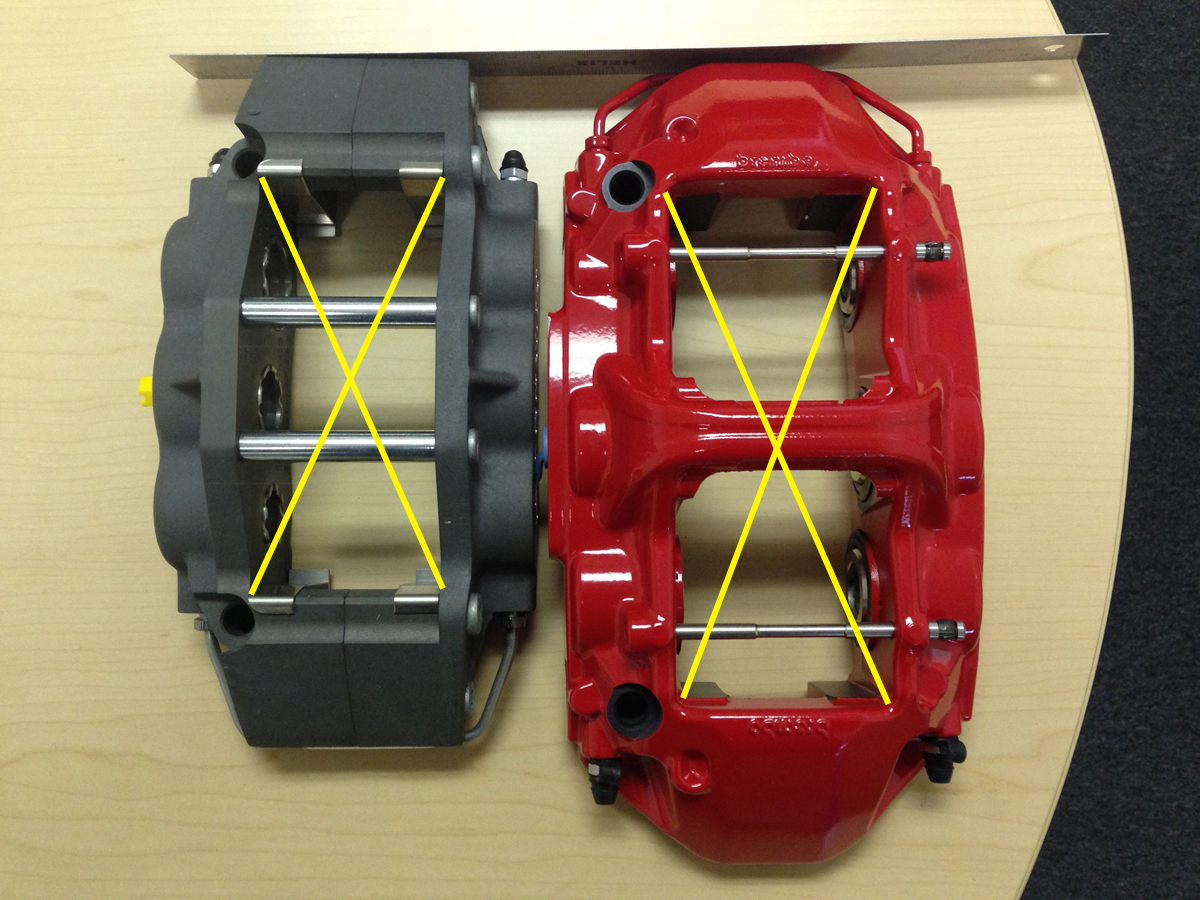AP Racing six piston vs. Brembo street six piston
03.25.2014We've had a number of customers ask how the calipers in our Essex Designed Competition Big Brake Kits differ from those in some of the competitive offerings on the market. In most cases, the customer is usually comparing racing components vs. road components. Racing calipers and road calipers are designed and produced with different goals in mind. The AP Racing caliper we're using was designed to be compact, lightweight, and durable on the racetrack. The Brembo Mono 6 we're comparing against in this article is functional, but some of the design objectives also included looking cool and working on Escalades! As such, it is larger and heavier than is strictly necessary for sports car and sedan applications. It's simply not as purpose built. That's what it ultimately boils down to when comparing calipers such as these.
In this article I'm going to take a look at the AP Racing CP5060 from our Competition Big Brake Kits, and compare it to the Brembo Mono 6, which is found in Brembo's GT line of BBK's.
Dimensions
- The AP Racing CP5060 is smaller dimensionally than the Brembo Mono 6. It is 2" shorter, and 20mm narrower. As you can see in the pics, it also isn't as tall. What this means is that the AP Racing caliper has tighter packaging, and better wheel clearance.
- Despite having stainless steel pistons, the CP5060 is also 1.4 lbs. lighter than the Mono 6, saving unsprung weight. The AP caliper doesn't need the huge pistons required to drag a loaded SUV to a halt, so it doesn't have as much mass to its body.
- Also notice that the "box" where the pads rest is shorter and more square on the AP Racing caliper (shown as a yellow X on the calipers). All else held equal, a shorter, more square 'pad box' increases overall caliper stiffness.



Construction
The Brembo is a forged Monobloc, vs. the AP Racing's cast two-piece construction. It's generally promoted that a monobloc is always going to be stiffer than a two-piece caliper (I don't have any actual stiffness data on these two, so I can't compare them in that area). That's not necessarily true. The bolts holding the two caliper halves together are quite stiff, and many manufacturers (including AP Racing) have proven that there is no inherent problem with a two-piece design. In many cases the customer actually strongly prefers the two-piece construction for ease of pad changes!
Pad shape and Changing pads
- Overall pad volume is very similar between the two pads being used in these calipers. The Mono 6 pads are longer and narrower vs. the ones used in the CP5060. Below are a few pictures comparing their profiles.
- Both pad shapes are available in a wide range of compounds, although I believe the CP5060 is available from more manufacturers. Spare pad pricing will be in the same ballpark for both shapes from most manufacturers.
- Pad changes are much less of a hassle on the AP Racing caliper. You only have to remove the two bridge pins with a hex head wrench and drop in the new pads (none of the holes on the top edge of the pad are used to retain them). With the Brembo you have to remove the caliper and the two bridge pins (usually with a hammer and a punch). Install the pads, reinsert the two pins, then remount the caliper. You also have to rest the caliper somewhere while it is unmounted, so it doesn't put strain on, or twist, the brake line.

Friction puck radial depth comparo, with the top edge of the friction pucks lined up...48mm vs. 54mm

Pad drawings with dimensions:
Brembo Mono 6= 189.6 x 48.0 x 17.5mm

AP Racing CP5060=152.1 x 54.0 x 18.0mm

Internals
- The Brembo Mono 6 has ordinary aluminum pistons with dust boots and no anti-knockback springs, no ventilation, and no domed back.
- The AP Racing CP5060 has domed-back, ventilated stainless steel pistons with 4 lb. anti-knockback springs. These are far superior to keeping heat out of the caliper/brake fluid, and help solve the knockback problem. They also don't have any dust boots to incinerate at the track.


Ultimately, both of these calipers are great products, but they have different intended uses and strengths. As with most components in the aftermarket, each customer has to decide for themselves which product is most closely aligned with their goals and needs.
Written by Jeff Ritter





Customer Comments:
No comments posted yet
You must be logged in to leave a Comment